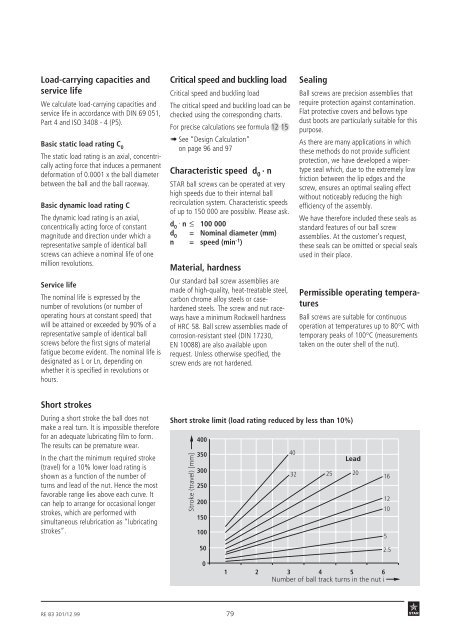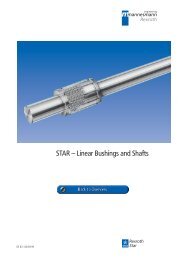STAR – Precision Ball Screw Assemblies
STAR – Precision Ball Screw Assemblies
STAR – Precision Ball Screw Assemblies
You also want an ePaper? Increase the reach of your titles
YUMPU automatically turns print PDFs into web optimized ePapers that Google loves.
Load-carrying capacities and<br />
service life<br />
We calculate load-carrying capacities and<br />
service life in accordance with DIN 69 051,<br />
Part 4 and ISO 3408 - 4 (P5).<br />
Basic static load rating C 0<br />
The static load rating is an axial, concentrically<br />
acting force that induces a permanent<br />
deformation of 0.0001 x the ball diameter<br />
between the ball and the ball raceway.<br />
Basic dynamic load rating C<br />
The dynamic load rating is an axial,<br />
concentrically acting force of constant<br />
magnitude and direction under which a<br />
representative sample of identical ball<br />
screws can achieve a nominal life of one<br />
million revolutions.<br />
Service life<br />
The nominal life is expressed by the<br />
number of revolutions (or number of<br />
operating hours at constant speed) that<br />
will be attained or exceeded by 90% of a<br />
representative sample of identical ball<br />
screws before the first signs of material<br />
fatigue become evident. The nominal life is<br />
designated as L or Ln, depending on<br />
whether it is specified in revolutions or<br />
hours.<br />
Short strokes<br />
During a short stroke the ball does not<br />
make a real turn. It is impossible therefore<br />
for an adequate lubricating film to form.<br />
The results can be premature wear.<br />
In the chart the minimum required stroke<br />
(travel) for a 10% lower load rating is<br />
shown as a function of the number of<br />
turns and lead of the nut. Hence the most<br />
favorable range lies above each curve. It<br />
can help to arrange for occasional longer<br />
strokes, which are performed with<br />
simultaneous relubrication as “lubricating<br />
strokes“.<br />
Critical speed and buckling load<br />
Critical speed and buckling load<br />
The critical speed and buckling load can be<br />
checked using the corresponding charts.<br />
For precise calculations see formula 12 15<br />
! See “Design Calculation“<br />
on page 96 and 97<br />
Characteristic speed d 0 · n<br />
<strong>STAR</strong> ball screws can be operated at very<br />
high speeds due to their internal ball<br />
recirculation system. Characteristic speeds<br />
of up to 150 000 are possiblw. Please ask.<br />
d0 . n ≤ 100 000<br />
d0 = Nominal diameter (mm)<br />
n = speed (min-1 )<br />
Material, hardness<br />
Our standard ball screw assemblies are<br />
made of high-quality, heat-treatable steel,<br />
carbon chrome alloy steels or casehardened<br />
steels. The screw and nut raceways<br />
have a minimum Rockwell hardness<br />
of HRC 58. <strong>Ball</strong> screw assemblies made of<br />
corrosion-resistant steel (DIN 17230,<br />
EN 10088) are also available upon<br />
request. Unless otherwise specified, the<br />
screw ends are not hardened.<br />
400<br />
350<br />
300<br />
250<br />
200<br />
150<br />
100<br />
RE 83 301/12.99 79<br />
Short stroke limit (load rating reduced by less than 10%)<br />
Stroke (travel) [mm]<br />
50<br />
0<br />
40<br />
Sealing<br />
<strong>Ball</strong> screws are precision assemblies that<br />
require protection against contamination.<br />
Flat protective covers and bellows type<br />
dust boots are particularly suitable for this<br />
purpose.<br />
As there are many applications in which<br />
these methods do not provide sufficient<br />
protection, we have developed a wipertype<br />
seal which, due to the extremely low<br />
friction between the lip edges and the<br />
screw, ensures an optimal sealing effect<br />
without noticeably reducing the high<br />
efficiency of the assembly.<br />
We have therefore included these seals as<br />
standard features of our ball screw<br />
assemblies. At the customer’s request,<br />
these seals can be omitted or special seals<br />
used in their place.<br />
Permissible operating temperatures<br />
<strong>Ball</strong> screws are suitable for continuous<br />
operation at temperatures up to 80°C with<br />
temporary peaks of 100°C (measurements<br />
taken on the outer shell of the nut).<br />
Lead<br />
32 25 20<br />
1 2 3 4 5 6<br />
Number of ball track turns in the nut i<br />
16<br />
12<br />
10<br />
5<br />
2.5



